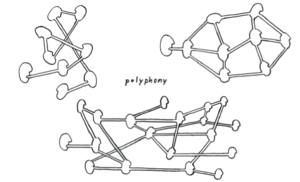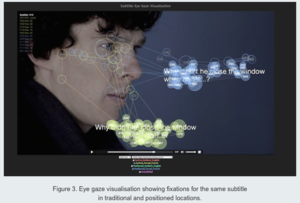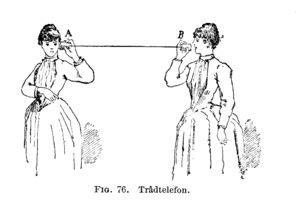Thematic-Navigating Borders and Contours: Difference between revisions
| Line 80: | Line 80: | ||
to collapse in subtitling, the activities of reading, hearing and seeing into one single activity, as if they were all the same. (...) | to collapse in subtitling, the activities of reading, hearing and seeing into one single activity, as if they were all the same. (...) | ||
it is because translation is perceived here as a part of the operation of suture that defines the classical cinema apparatus and the technological effort it deploys to naturalize a dominant, hierarchically unified worldview''. | it is because translation is perceived here as a part of the operation of suture that defines the classical cinema apparatus and the technological effort it deploys to naturalize a dominant, hierarchically unified worldview''. | ||
([http://trinhminh-ha.com/ Trinh T. Minha], Framer Framed, 1992) | ([http://trinhminh-ha.com/ Trinh T. Minha], Framer Framed, 1992) | ||
Revision as of 01:13, 13 January 2016
with Tina Bastajian
Synopsis
Sometimes it is almost impossible to infer whether or to what degree a narrator is fallible. (Wayne Booth -The Rhetoric of Fiction, 1961)
This thematic will interrogate in theory and praxis the mutable contours of narrative strategies from early cinema, modes of address in documentary practices, to more data-driven speculative scenarios. A variety of approaches will be explored, such as appropriating and re-positioning the conventions from the silent film era. Early film or the ‘cinema of attractions’ used live film ‘lecturers’ also known as ‘Explicateurs’ (Holland), or Benshi (Japan), that attracted viewers and propelled the silent narratives onscreen as well providing forms of translation for films with foreign language intertitles. Such constellations of display coalesce for example, with more contemporary practices known as the performance lecture, neo-benshi or even PechaKucha style presentations.
Throughout this thematic we will locate, re-contextualize, undermine and intervene with such strategies to produce new relationships and encounters with variations of fuzzy,* disembodied, unfaithful, or unreliable narrators [1] and hybrids thereof. The module will navigate in between the interstices of moving image/sound online archives providing an initial platform to consider one’s own work. This may also include forms of documentation, the underscoring of work processes, or constructing new spaces of speculation, inquiry, and spectatorship.
Public/Extended Text
While more narrative forms are exploited in the aforementioned practices, it is by working with, through and against such linear tendencies that also call upon us to reconsider the document and documentary forms. Thus, while thinking through the notion of the live ‘lecturer’ we might transpose this concept to the role of the voice or mediator commonly exploited in documentary or essay films, and the use of voice-over (VO), direct address, subtitles, and interviews. Mediators could also include handheld camera techniques (e.g. cinéma vérité /cinema truth) editing or compositional decisions. Such conventions within documentary practices act as carriers and purveyors of truth, authenticity, legibility, fidelity, etc. In contradistinction, these same conventions are exploited in ‘mockumentary’ film by manufacturing fake, confabulated, or partial truths. It is through these very fuzzy devices which also poignantly calls into question the malleability of storytelling practices, and complex issues such as memory and identity, in which to interrogate and subvert static and binary thinking.
When applying the documentary vernacular of fidelity for example to networked behaviors, what emerges from more unstable media could include unreliable browsers, themes of uncertainty, the glitch and the errant. (glitchbrowser) ([2] (blogspot.jodi.org) [3]) These attributes also reveal varying appearances of fuzzy, ambivalent or unreliable narrators such as networks that render “out of range” to other mis/readings whether they be analog, digital, networked or varying combinations. How might these and other errant behaviors and occurrences be incorporated, or translated to, with, alongside and beyond early film and documentary approaches to contour fuzzy and uncharted narrative strategies.
Coda
This and other modular thematics at Piet Zwart Institute, “aims to develop your understanding of your work in relation to others in the field and help you define your position within a broader cultural, technical and social contexts.”
*Fuzzy logic is a term that spans many disciplines. As a computational term, it was first coined by Dr. Lotfi Zadeh in 1965 and has been absorbed by other fields such as philosophy, engineering, mathematics, sociology, linguistics and statistics to name a few. “Zadeh looks around him in the real world which he finds pervaded by concepts which do not have sharply defined boundaries, where information is often incomplete or sometimes unreliable.” <http://www.azer.com/aiweb/categories/magazine/24_folder/24_articles/24_fuzzywhat.html>
Topics-by DAY
Monday: Locating the fuzzy, the unreliable
10:00-11:30 Introduction
- Outline of the thematic
- Strategies & Goals
- Reading assignment/Discussion
(break-away groups /main group)
11:30-11:45-BREAK
11:45-12:45
- Clips to screen/discuss
- Students present chosen fuzzy 'objects' (info on pre-charette forthcoming)
12:45-13:45 Lunch break
13:45-15:00
- Continue with fuzzy 'objects'
15:00-15:30 BREAK
15:30-17:30 Screenings
- (...)
- (...)
17:30-18:30 Dinner Break
18:30-20:30 Film screening and Group charrette work
Pre-reading (mandatory) for morning/afternoon discussion & praxis
- text forthcoming
- Germain Lacasse, “The Lecturer and the Attraction” in The Cinema of Attractions Reloaded, ed. Wanda Strauven (Amsterdam: Amsterdam University Press, 2006)
File:The Lecturer and the Attraction.pdf
- Essay on Cameo (live performance) Rachel Joseph, Screened stages and turbulent collisions, Performance Research, 19:5, 77-81, 2014
File:Cameo Text.Turbulent Screens.pdf
- Brief overview (neo)/Benshi: Tosh Berman http://www.altx.com/interzones/kino2/benshi.html
- (neo-benshi programme notes) http://viz.ucsc.edu/wp/vizArchive/vizEventP92.pdf
- optional reading
Tuesday: Proxies, Subtitles and Other Slippages
The duration of the subtitles, for example is very ideological. (...) the attempt is always to protect the unity of subject; here to collapse in subtitling, the activities of reading, hearing and seeing into one single activity, as if they were all the same. (...) it is because translation is perceived here as a part of the operation of suture that defines the classical cinema apparatus and the technological effort it deploys to naturalize a dominant, hierarchically unified worldview. (Trinh T. Minha, Framer Framed, 1992)
10:00-11:30 Text review/discussion
- present working clips
Break 11:30-11:45
11:45-13:00 Screening:
Lunch 13:00 - 14:00
14:00- 17:00 Groups
Dinner 17:00-18:00
Screenings
- Call Cutta- A documentary by Arjan Dutt (2005) See the project Call Cutta: A Mobile Phone Theater[4] by Haug/Kaegi/Wetzel-
- Calendar - a film by Atom Egoyan (1991)
Pre-Reading for Tuesday:
- Sinha, Amresh. (2004) 'The Use and Abuse of Subtitles', in Atom Egoyan and Ian Balfour (eds) Subtitles: On the Foreignness of Film, MIT Press, 172-190.
- Timothy Barker. (2010) 'Aesthetics of the Error: Media Art, the Machine, the Unforeseen and the Errant.' In Mark Nunes (Ed.). Error: Information, Control, and the Cultures of Noise.
File:Aesthetics of Error.Barker.pdf
Wednesday: The Performance Lecture and Meta-Narratives
TBD




